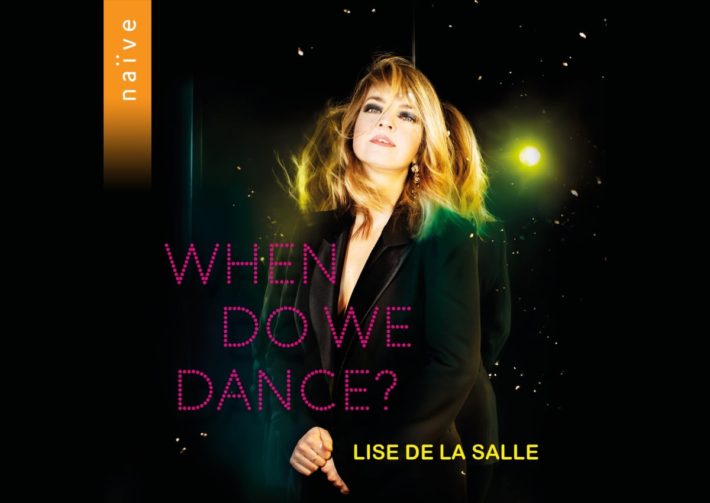At the center of this globe-trotting album is Ravel’s ‘Valses nobles et sentimentales’, flanked on either side by Ginastera’s Danzas Argentinas and Bartók’s ‘Romanian Folk Dances’, coupled with a selection of other miniatures. The Ravel and Bartók, along with some of the other pieces, are more familiar in their orchestral guises, sometimes it can be difficult to replicate the richness of color on the keyboard alone.
Pianist Lise de la Salle’s dexterity and rhythmic precision are impressive from the outset with the title track, Gershwin’s ‘When Shall We Dance?’. The balance between her hands is flawlessly executed, the right-hand projecting the melody while the left emphasizes the bass in the stride-style accompaniment. Art Tatum’s ‘Tea For Two’ follows, but stylistically these two pieces feel like one, which on repeated listening become a little dull. In both of these pieces, the top register of the piano lacks resonance, noticeably flattening the sound. Salle’s precision is meticulous but just lacks a little freedom and spontaneity.
Heading southwards to Argentina, Piazzolla’s famous ‘Libertango’ moves us to the streets of Buenos Aires. This acts as the link to Ginastera’s ‘Danzas Argentinas’. The pianistic colors are very monochromatic in both these works. The Piazzolla has some technical acrobatics which Salle tackles admirably, but the tone in the louder moments is excessively harsh, lacking the seductiveness of this highly charged music (for a vivid rendition look for Argerich, recordings of which are available as encores on some collections.) Salle’s slower central movement — ‘Danza de la moza donosa’, with its Chopinesque nocturne ambiance is the most musically expressive and convincing of these three pieces.
Related Classical Music Reviews
- Review: “labyrinth” – David Greilsammer, Piano
- Review: Four Recent Chopin Albums (2021)
- Review: Grażyna Bacewicz – Piano Music – Joanna Sochacka
Crossing the Atlantic Ocean to Europe, Salle arrives in Spain. In Falla’s ‘Ritual Fire Dance’, Salle confirms her agility, but the tone is often brittle and the contrasting legato and staccato passages appear more an act of demonstrating skill than musical expression. While the addition of glissandi are stylish, they do not add anything extra to her interpretation. Garrick Ohlsson, in his album of Falla’s piano music, showcases his vivid and exciting rendition to greater effect.
Ravel’s Schubert-inspired pastiche waltzes ‘Valses nobles et sentimentales’ lack the polish and refinement many pianists bring to the work, as Jean-Efflam Bavouzet, Krystian Zimerman, Arcadi Volodos or Arthur Rubinstein bring to the work. The first is a little heavy-handed, while the second misses a delicacy in the right-hand. In the eighth, the lack of resonance in the piano’s extreme high register fails to create the delicate layers of sound that these rather finely constructed pieces require.
Bartok’s Romanian Folk Dances are consistent in approach to the Ravel and Ginastera. The phrasing and ornamentation of the right-hand melodies are superb and executed with much rhythmic accuracy, maybe too much so; they sometimes come across more as technical exercises than dances. It’s the slower ‘Bucsum’ in which there is greater musical expression lacking in the other dances of the set.
Moving to Russia, Stravinsky’s ‘Tango’ and Rachmaninov’s ‘Polka Italiane’ are characterized by the angular tone consistent with the rest of the album. Here, as in the rest of the album, the recorded sound is decent but just a little dry, a rare case for Berlin’s famed Teldex Studio. The booklet lacks the expected program notes, containing only a brief interview with the pianist. This carefully considered and well-intentioned program looks intriguing on paper, and Salle’s keyboard skills are impressive throughout, yet the nuances needed to fully bring these pieces to life are not as abundant as one may hope for.

“When Do We Dance?
Gershwin: When Do We Dance?
Tatum: Tea for Two
Bolcom: The Graceful Ghost Rag
Waller: Viper’s Drag
Piazzólla: Libertango
Ginastera: Danzas Argentinas (3), Op. 2
Falla: Ritual Fire Dance (from El amor brujo)
Ravel: Valses nobles et sentimentales
Saint-Saëns: Etude en forme de valse (No. 6 from Six Études, Op. 52)
Debussy: Mazurka
Bartók: Romanian Folk Dances, Sz. 56, BB 68
Stravinsky: Tango
Scriabin: Waltz in A flat major, Op. 38
Rachmaninov: Polka italienne
Lise de la Salle – Piano
Naive, CD V5468
Recommended Comparisons
Read more classical music reviews or visit The Classic Review Amazon store
Follow Us and Comment:
[wd_hustle id=”HustlePostEmbed” type=”embedded”]











